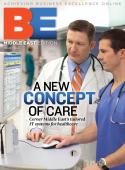Healthy outlookChristina Ayers, director of the Office for a Healthy Environment at Cleveland Clinic, one of the top five healthcare providers in the US, speaks to Ruari McCallion about sustainable improvement in the built and operating environment. You can tell a lot about the health of an organization by looking at its production of waste. ┬áIf everything is going into the same waste stream, regardless of source, quality or content, then expect malfunction inside the walls. If the back area is well organized, with different areas for reusable, recyclable and genuine waste products (a pile that should be very small), then the organization is likely to have a well-managed system and probably has lower costsÔÇöand therefore is more profitable. The concept of separating waste is already well established in health facilities. You donÔÇÖt put out radiology materials with biological, and neither of them should be sitting anywhere near cardboard, paper or other recyclable output. But waste and cost control begins further upstream, in purchasing, design and construction of both material and facilities. Cleveland Clinic, ranked one of the top five hospitals in the US, has its main campus southeast of downtown Cleveland, Ohio. It also has nine regional hospitals in the broader Northern Ohio area, as well as facilities in Florida, Canada, and Abu Dhabi in the Middle East. It is embedding effective solutions from the outset in its new buildings, since the establishment of its Office for a Healthy Environment in early 2007. ÔÇ£Cleveland Clinic is a large hospital and healthcare system that is making a big change,ÔÇØ says Christina Vernon Ayers, office director. ÔÇ£My office provides an overarching look at facilities, the environment, and all aspects of our operations, including our vehicle fleet, cleaning products, operational environment efficiency, recycling and waste management through an environmental lens. We have a key role to play in our new building program, in coordinating activities, looking for synergies and seeking out opportunities for improvement.ÔÇØ But why, in new build and refurbishment, are those functions not part of the project managerÔÇÖs remit?ÔÇ£I and my office donÔÇÖt replace the project managers; we supplement their needs,ÔÇØ she says. ÔÇ£Sustainability requires a root-and-branch approach. The Office for a Healthy Environment is not a cover-the-cracks, sticking-plaster solution. We look for opportunities to bring together people who donÔÇÖt normally interact. WeÔÇÖve established cross-functional ÔÇÿgreen teamsÔÇÖ in all our facilities that meet monthly, establish best practices and share information.ÔÇØ Many green initiatives in organizations across the economy have simply been cost-saving initiatives with a green sticker, but that isnÔÇÖt the Cleveland Clinic approach. One of its delivered values is the ability to plan and measure the benefits of taking a longer-term view over any short-term cash perspectives.ÔÇ£There are always cost implications, but it isnÔÇÖt straightforwardÔÇösome things have a front-end cost, some donÔÇÖt. In new buildings, orienting windows correctly and ensuring they work as theyÔÇÖre supposed to has no cost implication at all but has a huge impact,ÔÇØ says Ayers. ÔÇ£The next step may be motion sensors; they require relatively small capital investment, but the payback in energy savings is enormous. People get hung up on high-visibility initiatives, but they donÔÇÖt necessarily work. Photovoltaic panels, for example, are very visible, but they donÔÇÖt contribute much. Energy-saving light bulbs are relatively low-cost but deliver huge lifetime savings. WeÔÇÖre looking at whole-life costs; hospital buildings will be around for 30, 40 or 50 years, so itÔÇÖs worth investing upfront to deliver long-term benefits. The really substantial impact comes from good design.ÔÇØAnd itÔÇÖs toward the design area that AyersÔÇÖ office is focusedÔÇöcutting off problems before they come to passÔÇöand there is plenty of opportunity. Cleveland Clinic is currently undertaking three million square feet of new build, and the guiding principles for their energy and environmental performance are LEED specifications.ÔÇ£All new construction projects going forward are following LEED, and weÔÇÖve established a minimum standard of certification for our buildings, with Silver as our target,ÔÇØ she says. There is commitment to improved performance of the built environment from the top, which Ayers believes is the missing element in initiatives that have failed elsewhere. ÔÇ£If you get that message upfront, it gets people to put on a different hat and realize the way things will be done is different. We now have integrated support teams on all projects to ensure we get the building we need. WeÔÇÖre concerned, for example, about the health impacts of PVC; itÔÇÖs a good example of a complex problem of opportunity and risk. ItÔÇÖs everywhere, in plumbing, electrical, flooring, carpets, furniture, medical supplies and equipment. WeÔÇÖre looking for the best places to intervene, where we will have the most impact, and flooring is our number one target. ItÔÇÖs constantly agitated and is the highest risk, but itÔÇÖs the best opportunity. WeÔÇÖre converting all our flooring specification to PVC-free, and medical products also. As for items that will be behind wallsÔÇöthere are advantages in plumbing and electrical installations to using PVC, so weÔÇÖll watch marketplace developments.ÔÇØCleveland ClinicÔÇÖs LEED/sustainable buildings approach is being made manifest already. Its new garage and service center (1.2 million square feet) is substantially completed, as is an 80,000-square-foot office complex, but both incorporate elements of sustainable thinking. ÔÇ£Several projects are in design and planning, and weÔÇÖre investing significant time upfront to ensure compliance. These include expansion of our Hillcrest facility and two family health centers, in Twinsburg and Avon. They are a bit different from a large-scale hospital like Hillcrest; theyÔÇÖre smaller but more complex, in some ways. They offer a bit of everything, from physicianÔÇÖs offices to minor surgical procedures,ÔÇØ says Ayers. There are other projects at an early stage in the pipeline, which the Office for a Healthy Environment is actively involved in, right from the planning stage. ÔÇ£Whatever size the facility, there are challenges inherent in healthcare. We are a strictly regulated industry; our overriding need is for well-constructed, well-maintained buildings that function effectively in their given role.ÔÇØ ┬á









